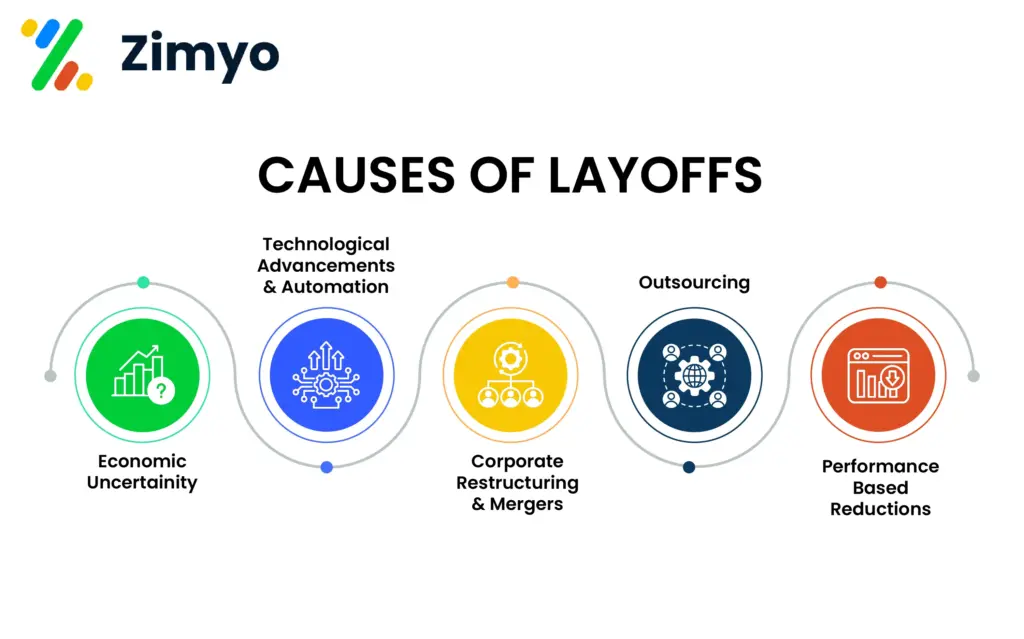In today’s dynamic corporate landscape, layoffs have become an increasingly prevalent phenomenon, driven by a confluence of economic, technological, and organizational factors. This glossary offers a comprehensive overview into the multifaceted nature of layoffs, examining their causes, impacts, and the current trends shaping the corporate world in 2025.

What Is a Layoff?
A layoff refers to the termination of employment by an employer, often due to reasons unrelated to the employee’s performance. Unlike dismissals for cause, layoffs are typically the result of external or organizational factors such as economic downturns, restructuring, or technological changes.
In short laying off meaning refers to the process of terminating an employee due to business needs, not misconduct.
Company layoff meaning: When a company lets go of multiple employees to cut costs, restructure, or survive tough times.

Causes of Layoffs in 2025
Several key factors are contributing to the rise in employee layoffs across various industries:
1. Economic Uncertainty:
Global economic challenges, including inflation, changing consumer demand, and geopolitical tensions, have led companies to adopt cautious spending policies, often resulting in workforce reductions to maintain financial stability.
2. Technological Advancements and Automation:
The rapid integration of artificial intelligence (AI) and automation technologies is reshaping job roles, leading to redundancies in positions that can be automated. For instance, nearly 70% of employers are laying off workers to save money, with about 40% doing so by incorporating AI.
3. Corporate Restructuring and Mergers:
Mergers, acquisitions, and internal restructuring efforts often lead to the elimination of overlapping roles and departments, resulting in job cuts.
4. Outsourcing:
To reduce operational costs, companies are increasingly outsourcing tasks to external vendors or offshore locations, leading to job cuts in domestic operations.
5. Performance-Based Reductions:
Some organizations are intensifying performance evaluations to identify underperforming employees for layoffs. For example, Meta has instructed managers to label a higher number of employees as “below expectations,” potentially affecting up to 20% of its workforce.
Check Out Our Blog on AI and Jobs Relation’
Impact of Layoffs
Job cuts have profound effects not only on those who lose their jobs but also on the remaining workforce and the organization as a whole:
On Affected Employees:
- Financial Strain: Sudden job loss can lead to immediate financial difficulties, especially for those without substantial savings or alternative income sources.
- Emotional and Psychological Stress: Layoffs can cause feelings of rejection, anxiety, and depression, impacting mental health and well-being.
On Remaining Employees:
- Increased Workload: The redistribution of tasks among fewer employees can lead to burnout and decreased job satisfaction.
- Decreased Morale and Trust: Witnessing colleagues being laid off can erode trust in management and reduce overall morale.
On Organizational Culture:
- Erosion of Company Culture: Frequent layoffs can create a culture of fear and uncertainty, affecting collaboration and innovation.
- Reputational Damage: Laying off can harm a company’s reputation, making it difficult to attract and retain top talent.
Current Trends in Corporate Layoffs
Several notable trends are emerging in the realm of corporate layoffs in India and globally:
1. AI-Driven Workforce Reductions:
The adoption of AI technologies is leading to the automation of various roles, particularly in customer service and administrative functions.
2. Quiet Layoffs or "Quiet Cutting":
Some companies are reassigning employees to less desirable roles instead of outright layoffs, a practice known as “quiet cutting.” This strategy aims to reduce headcount indirectly by encouraging voluntary resignations.
3. Sector-Specific Layoffs:
Industries such as retail, automotive, and consulting are experiencing significant layoffs due to factors like changing consumer behaviors, technological disruptions, and economic pressures.
4. Startup Struggles
Many startups in India, especially in fintech and edtech, have announced layoffs due to funding shortages and unstable revenue.
5. Global Impact:
Layoffs are not confined to a single region; companies worldwide are adjusting their workforce in response to global economic challenges. For example, Volvo Cars has announced a cut of 3,000 jobs as part of a major restructuring effort.
Strategies for Navigating Layoffs
For organizations and employees alike, proactive strategies can mitigate the adverse effects of layoffs:
For Employers:
- Transparent Communication: Clearly communicating the reasons behind layoffs can help maintain trust and morale among remaining employees.
- Support Services: Providing outplacement services, counseling, and career support can assist affected employees in transitioning to new opportunities.
- Investing in Employee Development: Offering training and upskilling programs can prepare employees for evolving job requirements, reducing the need for future layoffs.
Don’t:
- Announce layoffs abruptly or insensitively.
- Ignore the impact on remaining team members.
- Rush the process without planning.
For Employees:
- Continuous Learning: Engaging in lifelong learning and skill development can enhance employability and adaptability in a changing job market.
- Networking: Building and maintaining professional networks can open doors to new job opportunities and career growth.
- Financial Planning: Establishing an emergency fund and managing expenses prudently can provide a safety net during periods of unemployment.
- Be honest and empathetic during communication.
- Offer support like severance, resume help, and references.
- Provide mental health assistance and outplacement services.
Final Thoughts
“Layoffs Are Hard, But Understanding Helps”
Understanding the true layoff meaning goes beyond definitions. It’s about recognizing the human side of business decisions. Whether you’re laid off or managing a company layoff, awareness, empathy, and planning go a long way.
In a world where change is constant, the best approach is to stay informed, adaptable, and prepared.
FAQs:
What is the layoff meaning in HR?
In HR terms, a layoff is the termination of an employee due to business-related reasons—not because of their behavior or performance.
What is the difference between being fired and being laid off?
Being laid off is not your fault—it’s the company’s decision. Being fired usually means the employee did something wrong.
Are layoffs happening in India now?
Yes. Especially in tech, startup, and manufacturing sectors, layoff in India has seen a spike due to cost-cutting, funding issues, and automation.
